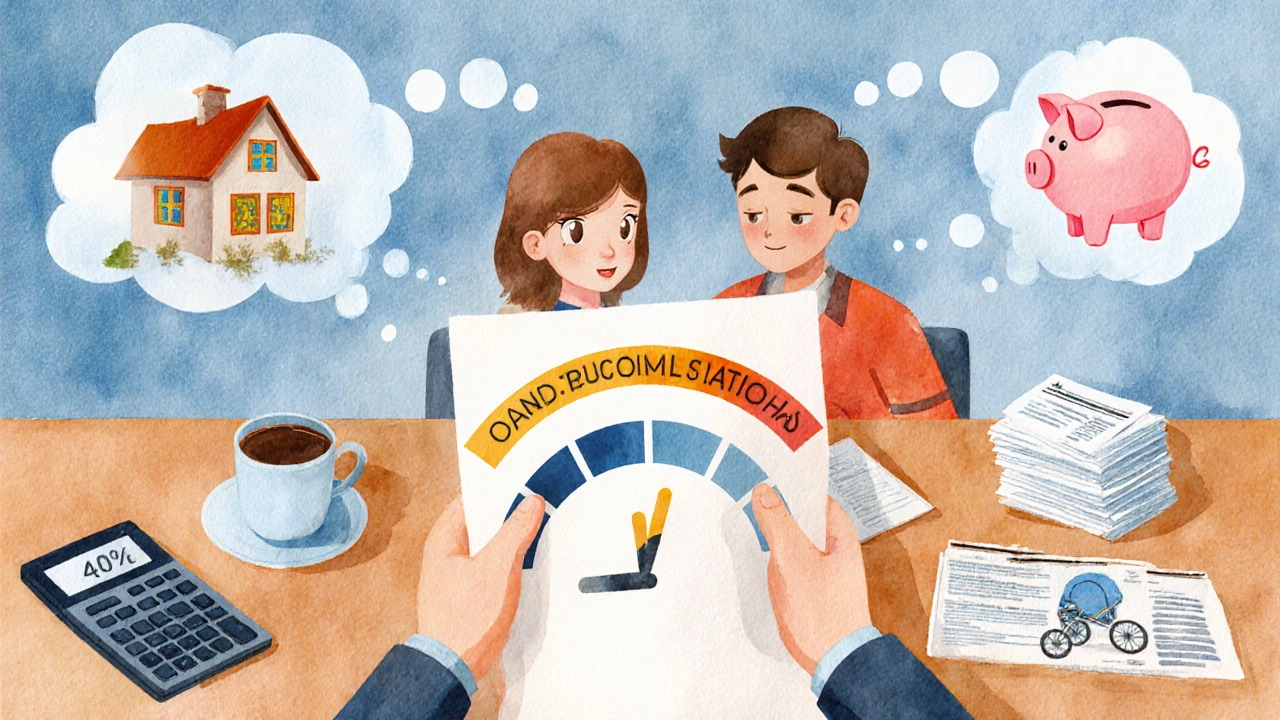Student Debt Repayment Calculator
Repayment Options Calculator
Calculate how different repayment plans affect your $100,000 student loan. Input your details to see monthly payments, total interest, and time to pay off.
Important Note: Income-driven repayment plans (REPAYE, PAYE, IBR) base payments on your income and family size. The values shown here assume a 10% discretionary income calculation as a rough estimate.
For most borrowers, these plans can reduce monthly payments significantly but increase total interest over time.
Key Takeaways
- $100,000 is more than three times the current U.S. average student loan balance.
- Carrying that amount can push major milestones-home purchase, retirement savings, family planning-back by years.
- Income‑driven repayment plans and loan‑forgiveness programs can reduce the burden dramatically if you qualify.
- Regularly monitoring your credit score and debt‑to‑income ratio helps you avoid default and keep borrowing costs low.
- A structured payoff strategy-refinancing, extra payments, or targeted forgiveness-turns “unmanageable” into “manageable.”
When you hear someone say they owe student debt of $100,000, the first reaction is usually “wow, that’s huge.” But “huge” is relative. To decide whether $100,000 is a lot, you need a benchmark, an idea of how it changes everyday life, and a roadmap for handling it.
Student loans come in two flavors: federal and private. Federal loans-such as Direct Subsidized, Direct Unsubsidized, and PLUS loans-are backed by the U.S. government and offer fixed interest rates and flexible repayment options. Private loans come from banks or credit unions, often carry variable rates, and provide fewer protections.
How $100,000 Stacks Up Against the Average
The most recent data from the Federal Reserve shows the average student loan balance for borrowers who have finished school sits at about $30,200. That means a $100,000 balance is over three times the norm. Even among borrowers who attended graduate school, the median debt is roughly $65,000, still well below the $100k mark.
Geography matters, too. In high‑cost states like California and New York, the average debt climbs to $40,000-$45,000, while in lower‑cost regions it hovers around $20,000. So, regardless of where you live, $100,000 remains an outlier.
Financial Impact on Life Goals
Every dollar of debt affects two key ratios that lenders look at: the debt‑to‑income ratio and the credit utilization impact on your credit score. A typical mortgage lender prefers a DTI under 36%. If you earn $70,000 a year and allocate $1,200 a month to student loan payments, your DTI could easily top 40%, limiting your ability to qualify for a home loan.
Retirement planning suffers as well. Financial planners often advise saving at least 15% of your gross income for retirement. With a large loan payment, many borrowers cut back on retirement contributions, losing out on compound growth. A simple calculation shows that missing a 15% contribution for 10 years, on a $70,000 salary, can shave off roughly $250,000 in retirement assets by age 65.
Family planning, career flexibility, and even mental health feel the pinch. The National Student Loan Data System reports that borrowers with balances above $80,000 are 30% more likely to delay marriage or child‑rearing.

Repayment Options That Matter
Facing $100,000 doesn’t mean you have to stick with the standard 10‑year, fixed‑payment plan. Federal borrowers can switch to an income‑driven repayment (IDR) plan, which caps monthly payments at a percentage of discretionary income. The three major IDR programs are:
- Revised Pay As You Earn (REPAYE) - 10% of discretionary income, 20‑year term for undergraduate loans, 25‑year for graduate.
- Pay As You Earn (PAYE) - 10% of discretionary income, 20‑year term, forgiveness of any remaining balance after 20 years.
- Income‑Based Repayment (IBR) - 10-15% of discretionary income, 20-25‑year term depending on when the loan was taken.
Choosing an IDR plan can drop a $100,000 loan payment from $1,100 per month (standard 10‑year schedule at 5% interest rate) to as low as $300-400, depending on income. The trade‑off is a longer repayment horizon and potential tax consequences when the remaining balance is forgiven.
Loan Forgiveness Programs
If you work in the public sector, nonprofit, or teaching, the Public Service Loan Forgiveness (PSLF) program may wipe out the rest of your balance after 120 qualifying payments. To qualify, you must be on a qualifying repayment plan (usually an IDR plan), work full‑time for an eligible employer, and submit the annual Employment Certification Form.
Other forgiveness options include Teacher Loan Forgiveness (up to $17,500) and Income‑Driven Repayment forgiveness after 20-25 years. However, forgiven amounts are considered taxable income by the IRS, so you’ll need to plan for a possible tax hit.
Refinancing: When It Makes Sense
Refinancing can lower your interest rate, especially if you have a strong credit score. As of Q32025, the average private refinance rate for borrowers with a credit score above 750 sits at 4.2% fixed, compared with 5-6% rates on many original federal loans. By refinancing $100,000 at 4.2% over 20 years, the monthly payment drops to about $620, saving roughly $140,000 in interest over the life of the loan.
Beware: refinancing federal loans into private ones means you lose access to IDR plans, PSLF, and other protections. Only refinance if you’re confident you won’t need those benefits.

Practical Payoff Strategies
Here’s a step‑by‑step plan that works for most borrowers with high balances:
- Calculate your current DTI and determine how much you can comfortably allocate to loan payment each month.
- If you’re on a standard plan, switch to an IDR plan to reduce monthly cash‑flow strain.
- Check eligibility for PSLF or other forgiveness programs based on your employment.
- Boost your credit score by paying down any revolving debt, setting up automatic payments, and limiting new credit inquiries.
- When your credit score hits 720 or higher, shop for refinance offers that cut your interest rate by at least 0.5%.
- Make extra payments whenever possible, targeting the principal to shorten the term. Even $100 extra per month can shave off a year.
- Monitor your loan balance, interest accrual, and tax implications annually.
What $100,000 Looks Like in Numbers
| Plan | Interest Rate | Term | Monthly Payment |
|---|---|---|---|
| Standard 10‑yr | 5.0% | 10 years | $1,060 |
| REPAYE (10% discretionary) | 5.0% | 20-25 years | $350-$400 |
| Refinanced Private | 4.2% | 20 years | $620 |
| PSLF (after 120 payments) | 5.0% | 10 years then forgiveness | $350-$450 (varies) |
Notice how the standard plan demands a payment that can exceed many people’s entire rent budget. Switching to an IDR plan or refinancing can make the difference between staying afloat and defaulting.
Bottom Line
Student debt of $100,000 is unquestionably a heavy load, but it’s not an unsolvable problem. By comparing it to national averages, understanding its ripple effects on major life goals, and leveraging the right repayment or forgiveness options, you can keep the debt from derailing your future.
Frequently Asked Questions
Is $100,000 the highest amount of student debt anyone has?
No. While $100,000 is far above the average, some borrowers-especially those with multiple graduate degrees or professional school loans-carry $200,000 or more. The federal loan limit for graduate PLUS loans is $125,000 per academic year, and combined with private borrowing, balances can climb much higher.
Can I qualify for loan forgiveness with a $100,000 balance?
Yes, if you work in a qualifying public‑service job and make 120 on‑time payments under an IDR plan, the remaining balance can be forgiven through PSLF. Other IDR forgiveness after 20-25 years also applies, though the forgiven amount may be taxable.
Should I refinance a federal loan into a private loan?
Refinancing can lower your rate and payment, but you lose federal protections like IDR and forgiveness. Consider refinancing only if your credit score is strong, you have a stable income, and you’re confident you won’t need federal benefits.
How does a $100,000 loan affect my credit score?
The loan itself is a factor, but payment history matters most. Consistently on‑time payments can boost your score, while missed payments or default can drop it by 100 points or more. Keep utilization low on revolving accounts and avoid new hard inquiries to protect your score.
What’s the quickest way to reduce the balance?
Pay extra toward the principal whenever you can-particularly after any interest accrual period ends. Even small, regular overpayments shave years off the term and save thousands in interest.

